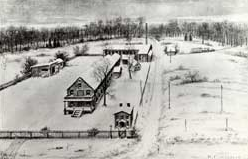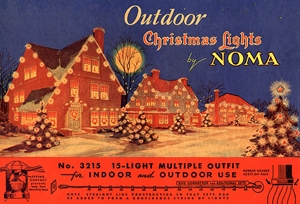The Story of Lighting Christmas

There’s a reason that traditions begin and then endure over time.
December 21st, or sometimes the 22nd, of the Gregorian calendar is the winter solstice. It’s the time when the Earth’s
northern axis points farthest away from the Sun, resulting in the shortest period of daylight for locations in the
Northern Hemisphere. This marks the beginning of the winter season since the reduced solar energy
brings colder temperatures.

In medieval Germany a pagan ritual began of people bringing evergreen branches into their homes to celebrate life
and maintain a connection with nature through this cold and dark period. People had a psychological need to stay
hopeful through the winter months until spring. Historical records of this period are unclear about exact dates and
developments, but it is known that this ritual gradually grew more elaborate to include whole trees and fancy
decorations.
Sometime during the 17th century, candles were used to illuminate these
decorated trees. At first they were crudely fastened, then ornamental holders
were manufactured to match the style of the other decorations. This tradition
had also combined with the Roman candle lighting ceremony of the winter solstice and the Christian celebration of
Christmas, and they became known as Christmas trees.
Burning candles attached to a dry tree made fires a common problem and the
opportunity for a safer replacement for illumination was great!

Edison's Menlo Park laboratory in winter
In 1878, inventor Joseph Swan received a British patent for an incandescent lamp using a conductive filament in a
glass vacuum bulb. This lamp was highly inefficient and had a short lifespan. A year later, in 1879, Thomas
Edison developed a much improved incandescent lamp. A higher resistance filament gave it better efficiency, and a
more complete vacuum in the bulb gave it a much longer life. These improvements allowed the incandescent lamp to be
a commercial success, and for that reason Edison is widely thought of as the inventor of the light bulb.
Thomas Edison was a skilled marketer in addition to his technical and inventive talents. During the Christmas
season of 1880 he assembled an electric light display outside his Menlo Park, New Jersey laboratory to impress the
public and potential investors. A witness commented, “In every direction stretched out long lines of electric
lights, whose luster made wide circles on the white-clad earth. One could not tire of gazing at those starry
lines.”
Two years later, Edward H. Johnson, vice-president of the Edison Electric Light Company, had red, white, and blue
Christmas tree bulbs specially made. He displayed these lights on the tree at his New York City home on
December 22, 1882, and became known as ‘the father of electric Christmas tree lights’.

For quite a while Christmas lights were expensive and often required professional hookup and installation, and
for this reason they were primarily used by the wealthier classes. Manufacturing technology improvements,
however, began to make them less expensive and more available to the general public. In 1925, the National Outfit
Manufacturer's Association (NOMA) was formed. It was a trade group of electrical lighting manufacturers who were
trying to gain a competitive advantage in the manufacture and selling of these electric Christmas lights. The
association incorporated in 1953 as NOMA Lites, Inc., but faced difficult competition from foreign imports by the
1960s. Currently NOMA exists as a licensed name only, though many readers of this article may remember the NOMA
brand lighting their homes and trees since they were very popular for a long period of time.
Over the past several years LED (light emitting diode) technology has begun to replace incandescent technology
for Christmas and holiday lighting. Mass production methods have made LED lights cost-competitive with the
incandescent types, and they have some advantages over the older technology. Since they don’t use heat to
generate light they are more energy efficient. They also have a much longer lifespan than an incandescent
filament. Some people also prefer their more pure color output, though that preference isn’t unanimous. For
‘white’ lights, incandescent gives off a warmer, more comforting glow that’s still preferable to many.
For hard-core decorating enthusiasts there are multi-circuit lighting
controllers that can operate from a home computer using dedicated software.
These systems can be custom programmed to synchronize the lights to holiday
music or produce unique patterned visual displays of any kind. With today's technology the
possibilities are endless and pretty much limited only by imagination.
There’s been an amazing evolution in the ways that we light Christmas and the holidays, but the basic reason
seems to have remained the same - to illuminate and inspire our spirits in the celebration of life.
